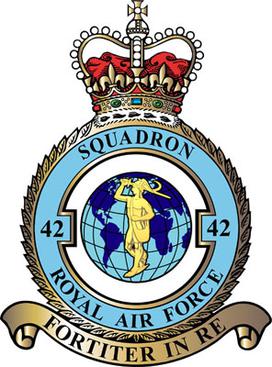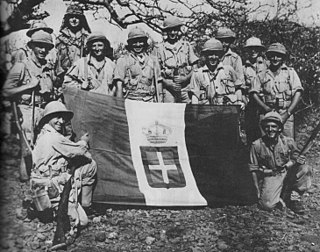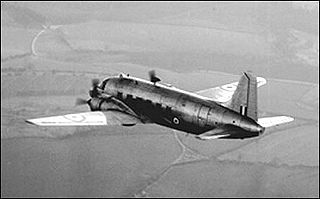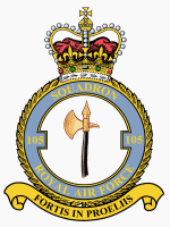The 1966 Defence White Paper was a major review of the United Kingdom's defence policy initiated by the Labour government under Prime Minister Harold Wilson. The review was led by the Secretary of State for Defence, Denis Healey. The document was centred on the need to support NATO in Europe and made the commitment that the UK, "would not undertake major operations of war except in co-operation with allies." The 1966 announcements undertook to retain the UK presence in Singapore and Malaysia.

The Bristol Type 171 Sycamore is an early helicopter developed and built by the helicopter division of the Bristol Aeroplane Company. The name refers to the seeds of the sycamore tree, Acer pseudoplatanus, which fall with a rotating motion. It has the distinction of being the first British helicopter to receive a certificate of airworthiness, as well as being the first British-designed helicopter to be introduced by and to serve with the Royal Air Force (RAF).

Number 42 Squadron, also known as No. 42 Squadron, is a squadron of the Royal Air Force. It reformed at RAF Lossiemouth on 21 September 2023 as the Operational Conversion Unit for both the Boeing Poseidon MRA1 and Boeing Wedgetail AEW1.

The East African campaign was fought in East Africa during the Second World War by Allies of World War II, mainly from the British Empire, against Italy and its colony of Italian East Africa, between June 1940 and November 1941. The British Middle East Command with troops from the United Kingdom, South Africa, British India, Uganda Protectorate, Kenya, Somaliland, West Africa, Northern and Southern Rhodesia, Sudan and Nyasaland participated in the campaign. These were joined by the Allied Force Publique of Belgian Congo, Imperial Ethiopian Arbegnoch and a small unit of Free French Forces.

No. 84 Squadron of the Royal Air Force is at present a Search and Rescue Squadron based at RAF Akrotiri, using the Westland/Airbus Helicopters Puma HC Mk.2 helicopter. The squadron transitioned from the previously operated Bell Griffin HAR.2 to the Puma HC.2 in 2023.

The Aden Protectorate was a British protectorate in southern Arabia. The protectorate evolved in the hinterland of the port of Aden and in the Hadhramaut after the conquest of Aden by the Bombay Presidency of British India in January 1839, and which continued until the 1960s. In 1940, it was divided for administrative purposes into the Western Protectorate and the Eastern Protectorate. The territory now forms part of the Republic of Yemen.

The State of Aden was a state constituted in Aden within the Federation of South Arabia. Following its establishment on 18 January 1963, Sir Charles Johnston stepped down as the last Governor of Aden.

The Bristol Type 192 Belvedere is a British twin-engine, tandem rotor military helicopter built by the Bristol Aeroplane Company. It was designed by Raoul Hafner for a variety of transport roles including troop transport, supply dropping and casualty evacuation. It was operated by the Royal Air Force (RAF) from 1961 to 1969. The Belvedere was Britain's only tandem rotor helicopter to enter production, and one of the few not built by Piasecki or Boeing.

The Aden Emergency, also known as the 14 October Revolution or as the Radfan Uprising, was an armed rebellion by the National Liberation Front (NLF) and the Front for the Liberation of Occupied South Yemen (FLOSY) against the Federation of South Arabia, a British Protectorate of the United Kingdom, which led to the proclamation of the People's Republic of South Yemen.

The General Service Medal, is a campaign medal of the United Kingdom introduced in 1962 to replace both the General Service Medal (1918), as awarded to the Army and RAF, and the Naval General Service Medal (1915). The 1962 GSM was awarded until 2007, when it was replaced by the Operational Service Medal. In 2015 the General Service Medal (2008) was introduced.

The Vickers Valetta is a twin-engine military transport aircraft developed and produced by the British manufacturing company Vickers-Armstrongs Ltd. Developed from the Vickers VC.1 Viking compact civil airliner, it was an all-metal mid-wing monoplane with a tailwheel undercarriage.

The Italian invasion of British Somaliland was part of the East African campaign (1940–1941) in which Italian, Eritrean and Somali forces of Fascist Italy entered the Somaliland Protectorate and defeated its garrison of British, Commonwealth and colonial forces supported by Somali irregulars. The Italian victory was based on mobility and speed but was hampered by the terrain, rainy weather and British resistance.

No. 105 Squadron was a flying squadron of the Royal Air Force, active for three periods between 1917 and 1969. It was originally established during the First World War as a squadron of the Royal Flying Corps and disbanded after the war. Reactivated shortly before the Second World War, it was inactive again after the conflict. During its second existence it was a bomber unit and had the distinction to be the first to operate the de Havilland Mosquito light bomber. During the 1960s it was reactivated again for six years to provide transport support for the British Army in the Aden Protectorate and the Far East.

Royal Air Force Khormaksar or more simply RAF Khormaksar is a former Royal Air Force station in Aden, Yemen. Its motto was "Into the Remote Places". During the 1960s, it was the base for nine squadrons and became the RAF's busiest-ever station as well as the biggest staging post for the RAF between the United Kingdom and Singapore.
British Forces Aden was the name given to the British Armed Forces stationed in the Aden Protectorate during part of the 20th century. Their purpose was to preserve the security of the Protectorate from both internal threats and external aggression.
The Radfan Campaign was a series of British military actions during the Aden Emergency in January–May 1964. It took place in the mountainous Radfan region near the border with the Yemen Arab Republic. Local tribesmen connected with the NLF began raiding the road connecting with Aden with the town of Dhala.

No. 90 (Composite) Wing was a Royal Australian Air Force (RAAF) wing that operated during the early years of the Malayan Emergency. Its purpose was to serve as an umbrella organisation for the RAAF units deployed in the conflict, No. 1 (Bomber) Squadron, flying Avro Lincolns, and No. 38 (Transport) Squadron, flying Douglas C-47 Dakotas. The wing was established in July 1950 and headquartered at Changi, on the east coast of Singapore. No. 1 Squadron operated from Tengah, in Singapore's west. No. 38 Squadron was based at Changi and, from April 1951 to February 1952, at Kuala Lumpur in central Malaya. The Lincolns generally conducted area bombing missions, as well as precision strikes, to harass communist insurgents. The Dakotas were tasked with airlifting cargo, VIPs, troops and casualties, as well as courier flights and supply drops. Following No. 38 Squadron's departure in December 1952, No. 90 Wing was disbanded, leaving No. 1 Squadron to carry on as the sole RAAF unit in the Malayan air campaign until its withdrawal to Australia in July 1958.
The Battle of Crater or Operation Stirling Castle was an encounter in 1967 during the Aden Emergency. After the mutiny of the Arab Armed Police and ambush of British troops by them, the Crater district in Aden was abandoned by British troops. The British then decided to enter Crater and retrieve the bodies of dead British soldiers.
The Arab Police mutiny was an incident during the Aden Emergency where Arab soldiers and police mutinied against British troops. While the mutiny itself was localized and quickly suppressed, it undermined the South Arabian Federation which had been organized by Britain in 1959 as an intended successor to direct colonial rule.
The High Commissioner attack was an incident which saw the beginning of the Aden Emergency. Arab nationalists of the NLF made a grenade attack against the British High Commissioner, Sir Kennedy Trevaskis, killing one person and injuring 50.













